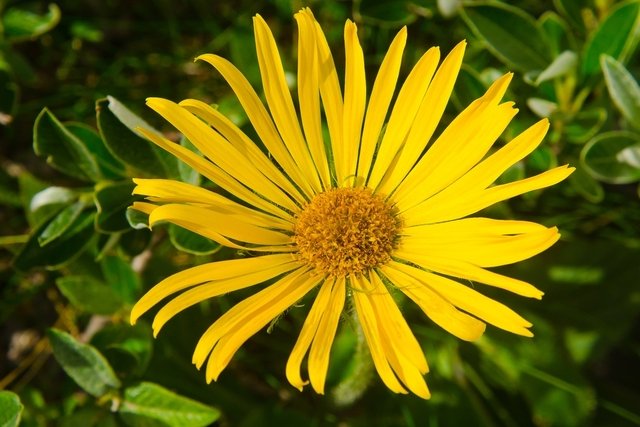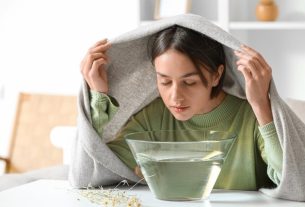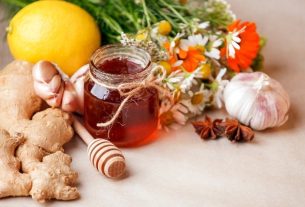Arnica is a medicinal plant of the species Arnica montana which can be used to help treat bruises, rheumatic pain, abrasions and muscle pain, for example, as it has anti-inflammatory, analgesic and anticoagulant properties.
The normally used parts of arnica are the dried flowers or leaves to prepare the tincture, arnica oil, homeopathic globules, ointment or gel, for example.
Although it has several health benefits, the use of arnica should only be done under the guidance of a doctor or herbalist, as it can cause several side effects, in addition to being contraindicated for pregnant women and people with liver problems.

What is it for
Due to its properties, arnica can be used to:
1. Wound healing
Some studies show that arnica has lactones with healing and anti-inflammatory properties, reducing the production of inflammatory substances such as prostaglandins and cytokines, and can be used to help treat skin wounds, abrasions, scratches, bruises or cuts, for example .
Furthermore, arnica has antihistamine action, which helps reduce the swelling of wounds by inhibiting the leakage of liquids from the blood vessels at the wound site.
Arnica, in the form of a gel or ointment, can be used in cases of bruises, trauma or blows that form a hematoma or ecchymosis under the skin, as it contains lactones, helenalin and hexuronic acid in its composition, with anticoagulant, analgesic and anti-inflammatory properties. inflammatory, which helps to reduce the bruise on the skin and pain at the site of the injury.
3. Joint pain
Because it contains helenalin in its composition, with a powerful anti-inflammatory action, arnica helps block the production of proteins responsible for chronic joint inflammation in people with osteoarthritis.
Some studies show that the topical use of arnica in osteoarthritis, by helping to relieve joint pain, improve movement and reduce morning stiffness in the hands.
4. Muscle pain or strain
Arnica helps to reduce pain and treat muscle strain caused by physical activities or in the case of torticollis, for example, due to the lactones in its composition with anti-inflammatory and analgesic action.
Furthermore, some studies show that arnica, when ingested in the form of homeopathic globules by marathon athletes, helps to reduce muscle pain caused by this type of sport, improving recovery time after the race.
5. Post-operative pain
Arnica, due to its analgesic, anti-inflammatory and healing effects, helps reduce inflammation in tissues after surgery, which helps to treat post-operative pain and swelling.
Furthermore, after surgery, it is normal for bruises to appear near the scar due to the rupture of blood vessels caused by the surgical cut, and arnica can help reduce bruises on the skin due to its anticoagulant effect. However, it should only be used after surgery when advised by a doctor and the scar has already closed.
6. Varicose veins and hemorrhoids
The lactones and hexuronic acid present in arnica have anticoagulant, anti-inflammatory and analgesic action and can be used to assist in the treatment of varicose veins and hemorrhoids, which are protruding dilated veins that appear under the skin or in the anal region, and, thus, this plant helps to reduce pain and discomfort.
7. Toothache and gingivitis
Due to its analgesic, anti-inflammatory, antiseptic, healing and antimicrobial effects, due to the presence of helenalin, arnica can be very useful in helping to reduce toothache or gingivitis, which is inflammation of the gums.
However, arnica should not be ingested due to its toxic effects, but can be used as a tea to gargle.
8. Boil
Arnica, as it contains lactones, flavonoids and phenolic compounds in its composition, has antiseptic, antimicrobial and anti-inflammatory action, helping to reduce inflammation and pain, and can help treat boils.
9. Baldness
Some studies using arnica show that the use of this plant together with other medicinal herbs such as jaborandi, chamomile or jojoba, in natural hair shampoo formulations, increases hair strength and growth, and can be an important ally in the fight against baldness.
How to use
The used part of arnica are the flowers that can be used in the form of tea, tincture, ointment or oil for external application.
It is important not to ingest arnica as it can cause poisoning. and, it should also not be used on open or bleeding wounds, bruises or surgical scars, as arnica can be absorbed through the skin and cause toxic side effects.
1. Arnica tea
The arnica tea compress is recommended for use in case of bruises, scratches, bruises and bruises on the skin, always in compress form.
Additionally, arnica tea can be used to gargle in case of sore throat or toothache, but it should never be ingested, as it can cause side effects, such as nausea, tremors and irregular heartbeats, in addition to in high doses it can be fatal.
Ingredients
- 1 teaspoon of dried arnica flowers;
- 250 mL of boiling water.
Preparation mode
Place the dried arnica flowers in boiling water and let it rest for 10 minutes. Strain, dip the compress and apply warm to the affected area 2 to 3 times a day.
Arnica infusion should not be applied to open or bleeding wounds, nor to the eyes.
2. Arnica ointment
Arnica ointment is a great option to apply to sore skin due to bruises, bumps or bruises because it relieves muscle pain and helps eliminate bruises very efficiently.
Ingredients
- 5 g of beeswax;
- 45 mL of olive oil or sweet almond oil;
- 4 tablespoons of chopped dried arnica leaves and flowers.
Preparation mode
Place the ingredients in a pan over a bain-marie and let it boil over low heat for a few minutes. Then, turn off the heat and leave the ingredients in the pan for a few hours to release the active substances. Before cooling, strain and store the liquid part in a clean, dry glass container with a lid.
Always keep the glass in a dry, dark and ventilated place. This ointment is valid for up to 1 year and can be applied to the skin 2 to 3 times a day.
3. Arnica tincture to apply to the skin
Arnica tincture, prepared with alcohol, is a great remedy for treating bruises caused by blows, bruises and muscle damage, as well as joint pain caused by osteoarthritis. This preparation should only be used on the skin and should not be ingested.
Ingredients
- 10 grams of dried arnica leaves;
- 350 mL of grain alcohol;
- 150 mL of filtered water.
Preparation mode
Grind the dried arnica leaves with a pestle to release the active substances. Then, place the crushed dry arnica leaves in a clean, dry glass jar with a lid, and add the alcohol and filtered water. Close the jar with the lid, cover the outside with aluminum foil and let it rest for 1 week.
It is important to shake the bottle every day. After 1 week, remove the arnica leaves from the solution and transfer the tincture to another clean, dry glass bottle covered with aluminum foil. This tincture is valid for up to one year.
Before using the tincture, the bottle must be shaken. Apply the arnica tincture to the desired locations 2 to 3 times a day using a cotton ball, massaging the area.
Arnica tincture should not be used on open or bleeding wounds as the alcohol in the tincture can cause the wound to burn.
4. Arnica oil
Arnica oil can be used to treat bruises, bumps, sprains, muscle pain, joint pain or swollen legs, due to its anti-inflammatory, analgesic and anticoagulant properties.
This oil should only be used on the skin and should not be consumed.
Ingredients
- 10 grams of dried arnica flowers;
- 100 mL of olive oil, almond oil or jojoba oil.
Preparation mode
Place the dried arnica flowers and oil in a clean, dry glass jar with a lid. Mix with a spoon, cover the jar and cover with aluminum foil. Shake the bottle well to help release the active substances in the arnica. Store the bottle in a cool place, away from light, for 30 to 40 days. After this period, strain the oil to remove the arnica flowers and store the oil in a clean, dry bottle with a lid, covered with aluminum foil. Arnica oil can be used 2 to 3 times a day on the affected area.
Possible side effects
Arnica is safe for most adults when used topically for a short period of time. However, this plant can cause skin allergies, swelling or dermatitis.
Arnica should not be ingested as it is considered a toxic plant.which can cause irritation in the mouth and throat, stomach pain, nausea, vomiting, diarrhea, hallucinations, dizziness, shortness of breath and cardiac complications, such as arrhythmia, increased blood pressure, muscle weakness, bleeding, coma and death.
You should seek medical help immediately or the nearest emergency room if you experience symptoms of poisoning or an allergic reaction to arnica, such as difficulty breathing, nausea, vomiting or convulsions.
When not to use
Arnica should not be used by people allergic to this plant or with liver disease, by children under 12 years of age, pregnant women as it can be abortive or during breastfeeding as it passes to the baby through breast milk.
This medicinal plant should also not be used on skin with open or bleeding wounds, or on the eyes, and should never be ingested, due to its toxic effects.
Furthermore, as it contains alcohol, the use of arnica tincture is not recommended for people undergoing treatment for alcoholism who use the medicine disulfiram.

Sign up for our newsletter and stay up to date with exclusive news
that can transform your routine!
Warning: Undefined array key "title" in /home/storelat/public_html/wp-content/plugins/link-whisper-premium/templates/frontend/related-posts.php on line 12
Warning: Undefined array key "title_tag" in /home/storelat/public_html/wp-content/plugins/link-whisper-premium/templates/frontend/related-posts.php on line 13



